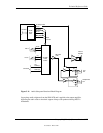
Chapter 5 Input/Output Interfaces
5-26 Compaq iPAQ Family of Internet Devices
First Edition – March 2000
5.8 AUDIO SUBSYSTEM
A PCI audio subsystem is integrated onto the system board of the Compaq iPAQ. Implementing
AC’97 design guidelines, the audio subsystem is designed to provide optimum sound. Key
features of the audio subsystem include:
♦
AC’97 ver. 2.1 compliance
♦
Multiple audio channel streaming
♦
Soft CD, DVD/AC-3 processing
♦
Wavetable synthesis utilizing system memory
♦
Acoustic echo cancellation
♦
16-bit stereo PCM input and output w/ up to 48 KHz sampling
5.8.1 FUNCTIONAL ANALYSIS
A block diagram of the audio subsystem is shown in Figure 5-11. The architecture uses the
AC’97 Audio Controller of the 82801 ICH component to access and control an Analog Devices
AD1881 Audio Codec, which provides the analog-to-digital (ADC) and digital-to-analog (DAC)
conversions as well as the mixing functions.
All control functions such as volume, audio source selection, and sampling rate are controlled
through software over the PCI bus through the AC97 Audio Controller of the 82801 ICH.
Control data and digital audio streams (record and playback) are transferred between the Audio
Controller and the Audio Codec over the AC97 Link Bus. Playback audio from the Audio Codec
is routed to a 5-watt low-distortion amplifier (TDA7056A) that drives a long-excursion large-
magnet speaker for optimum sound.
The analog interfaces allowing connection to external audio devices are discussed in the
following paragraphs.
Mic In
- This front panel-accessible input uses a three-conductor (stereo) mini-jack that is
specifically designed for connection of a condenser microphone with an impedance of 10-K
ohms. This is the default recording input after a system reset.
Line In
- This input uses a three-conductor (stereo) mini-jack that is specifically designed for
connection of a high-impedance (10k-ohm) audio source such as a tape deck.
Headphones Out
- This front panel-accessible input uses a three-conductor (stereo) mini-jack
that is specifically designed for connecting a set of 16-ohm (nom.) stereo headphones. Plugging
into the Headphones jack mutes the signal to the internal speaker and the Line Out jack.
Line Out
- This output uses a three-conductor (stereo) mini-jack for connecting left and right
channel line-level signals (20-K ohm impedance). A typical connection would be to a tape
recorder’s Line In (Record In) jacks, an amplifier’s Line In jacks, or to “powered” speakers that
contain amplifiers. Plugging into the Line Out mutes the internal speaker.


















